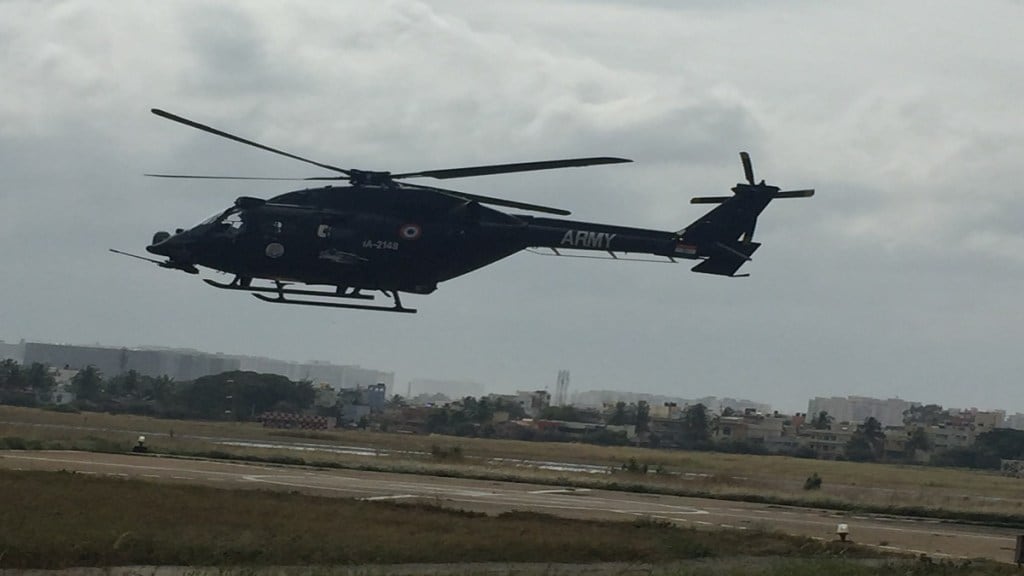An Advanced Light Helicopter (ALH) Dhruv with three people on board crashed following a “hard landing” in Jammu and Kashmir(J&K)’s Kishtwar district. A technician was killed and two pilots were injured during the crash landing.
This is the third serious incident involving an ALH Dhruv in the last two months.
According to the statement released by the Udhampur-based Northern Command, an Army Aviation ALH Dhruv helicopter on an operational mission made a precautionary landing on the banks of Marua river in the Kishtwar region of Jammu and Kashmir.
The recent crash of an indigenously developed Dhruv Advanced Light Helicopter (ALH) variant in J&K, raises serious reliability issues with 300-odd such helicopters under operation across the armed forces and the Coast Guard.
A total 336 ALHs in all its four variant types – developed and series manufactured by Hindustan Aeronautics Limited (HAL) – that were currently in service with all three-armed services and the Indian Coast Guard (ICG), were undergoing extensive checks, before receiving clearance to operate.
These crashes and mishaps, in turn, had led to the entire ALH fleet being periodically grounded for varying periods to complete rigorous checks on them before clearing them for take-off.
What is Advanced Light Helicopter or ALH-DHRUV?
The indigenously designed and developed Advanced Light Helicopter (ALH-DHRUV) is a twin-engine, multi-role, multi-mission new-generation helicopter in the 5.5-ton weight class. The basic Helicopter is produced in the skid version and wheeled version. Dhruv is “type –Certified” for Military operations by the Centre for Military Airworthiness Certification (CEMILAC) and for civil operations by the Directorate General of Civil Aviation (DGCA).
Certification of the utility military variant was completed in 2002 and that of the civil variant was completed in 2004. The deliveries of production series helicopters commenced from 2001-02 onwards. A total of 336 Helicopters have been produced by October 2022.
The major variants of ALH are classified as Mk-I Conventional cockpit; MK-II & Mk-III Glass cockpit; MK-III Maritime Role (Navy/ Coast Guard); and MK-IV-armed version.
The ALH is powered by TM 333 – 2B2 engine (For Dhruv Mk-I and Mk-II) & ARDIDEN 1H1 (Shakti) (for Dhruv Mk III & Mk IV).
Technical issues
Reports suggest mechanical errors at large.
Some of the technical issues which did crop up earlier have been resolved. As a senior IAF official who was part of the ALH’s development program points out the design characteristic of the rigid rotor system that the ALH is equipped with.
The ALH which was designed to fly at high altitude areas was tested for reliability. Dhruv is highly capable for operating at various altitudes from sea level to high altitudes of Himalayas as well as in Desert and saline atmospheric conditions at extreme temperature ranges.
However, he explained that a “rigid rotor gives it very high manoeuvrability, but it stalls if rolled and pitched beyond a certain rate. These design issues were resolved. Dhruv is incorporated with advanced technologies such as Hinge less Interchangeable Main Rotor Blades, Bearing less Tail Rotor Blades, Anti resonance vibration isolation system and redundancies built in for critical systems.
However, in many cases, the problems persisted especially the failure of ‘cyclic’ pitch — mechanical rods– that are connected to the rotors.
This has been the case with at least five accidents as he elaborates. The Indian army and the Indian air force operate much larger fleets of the Dhruv, and have experienced frequent technical failures.
While the Dhruv helicopter has transformed into an advanced search and rescue helicopter, also used for missions like heliborne operations and armed patrol with night vision devices, it is imperative that an investigation must conclude with resolutions.


